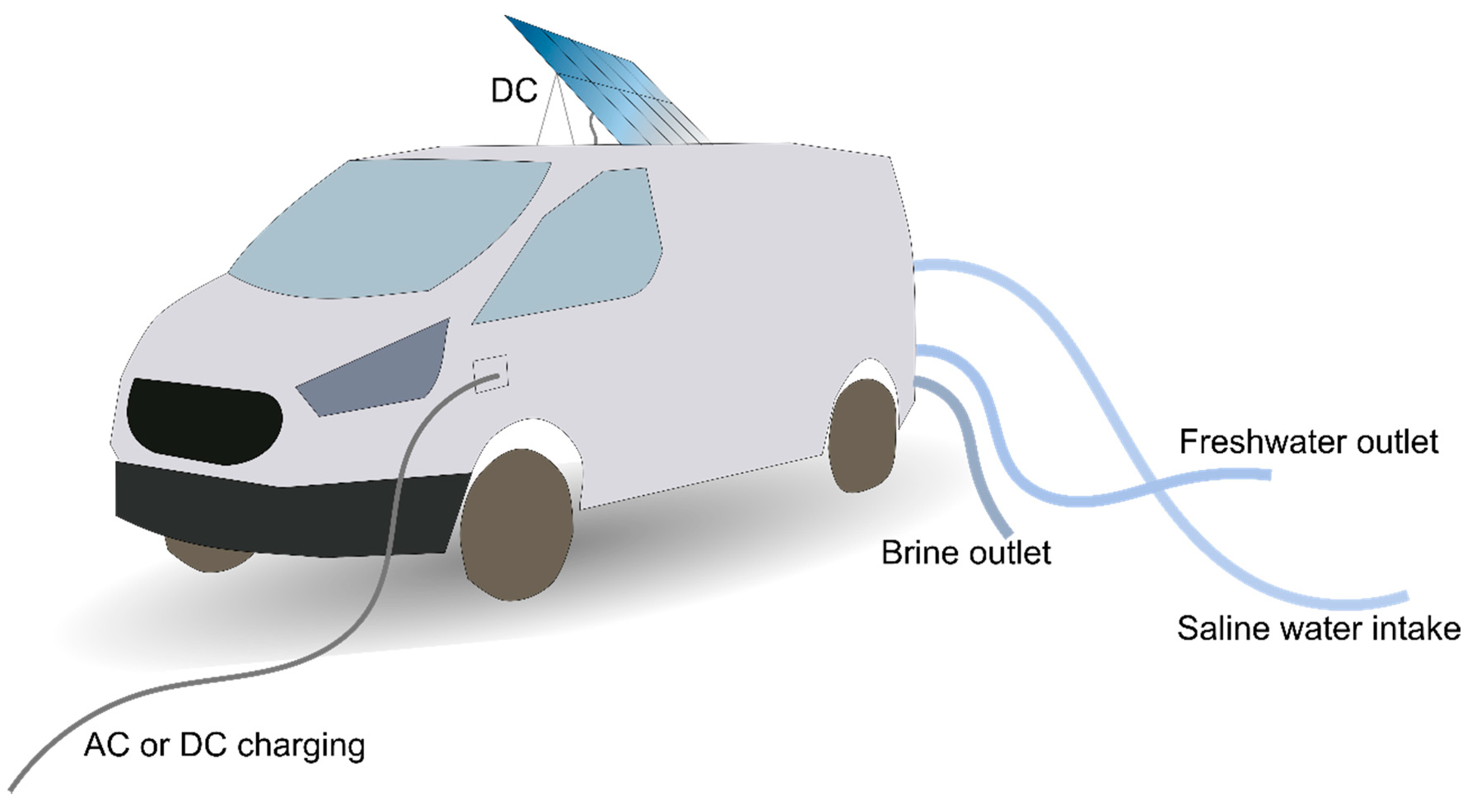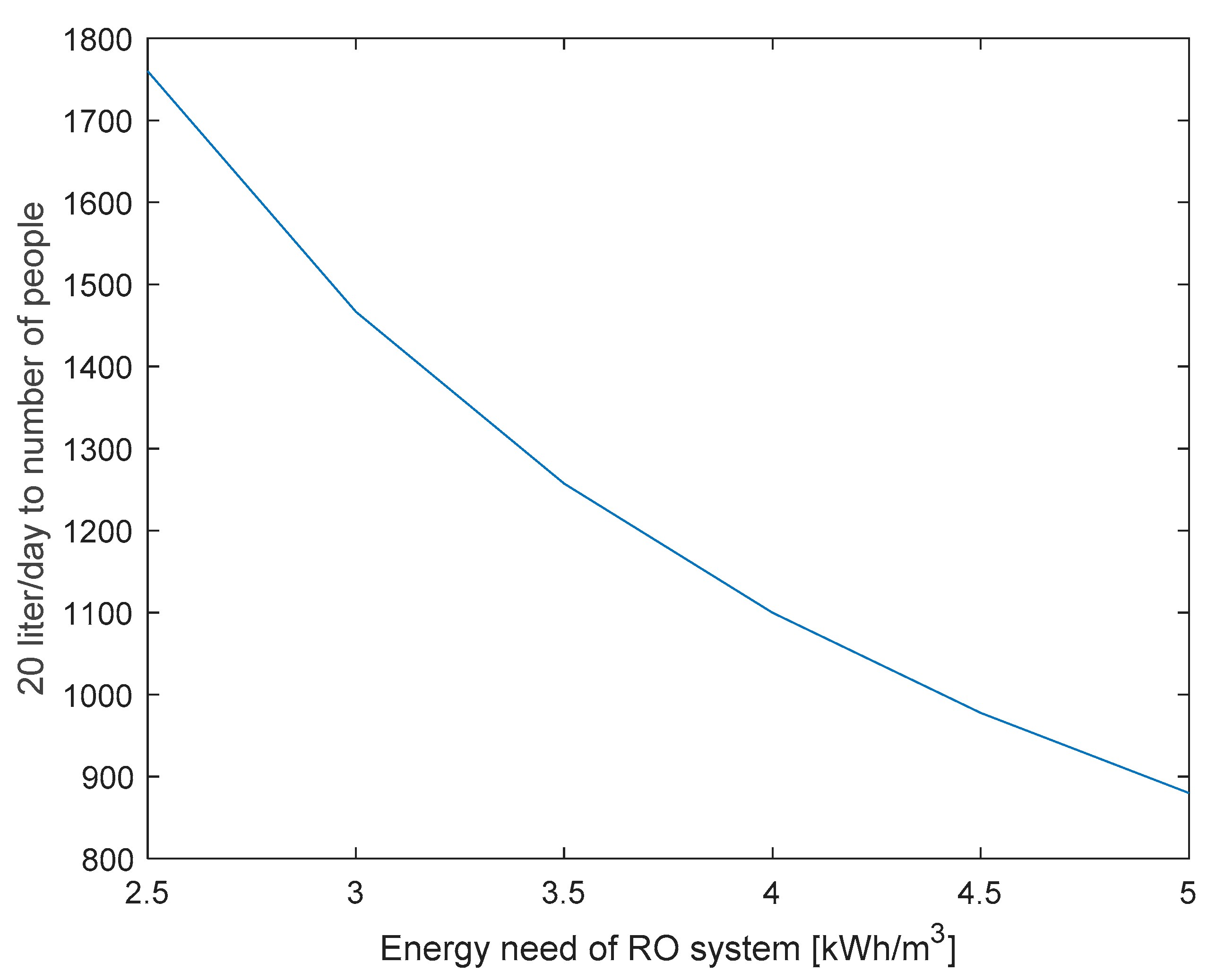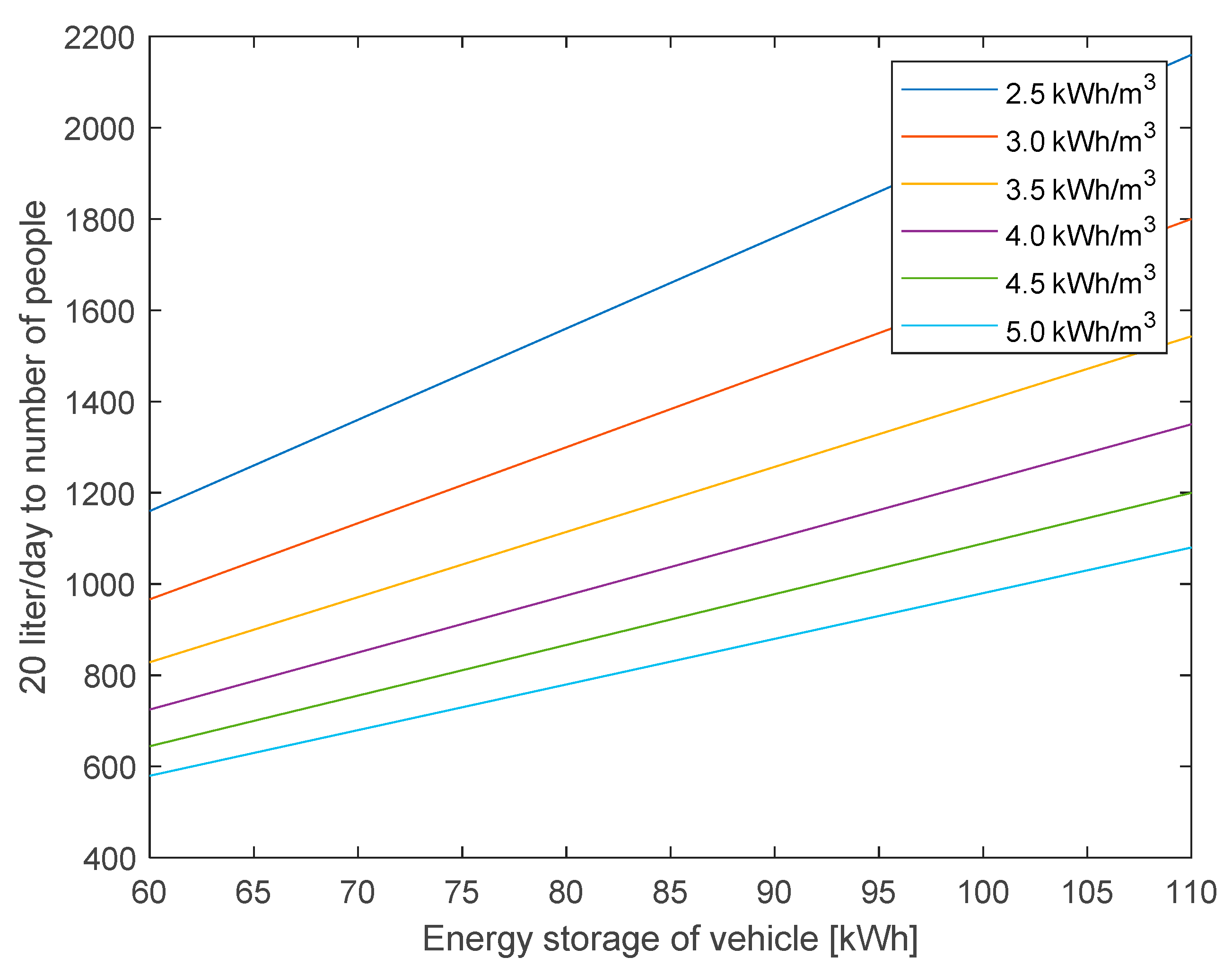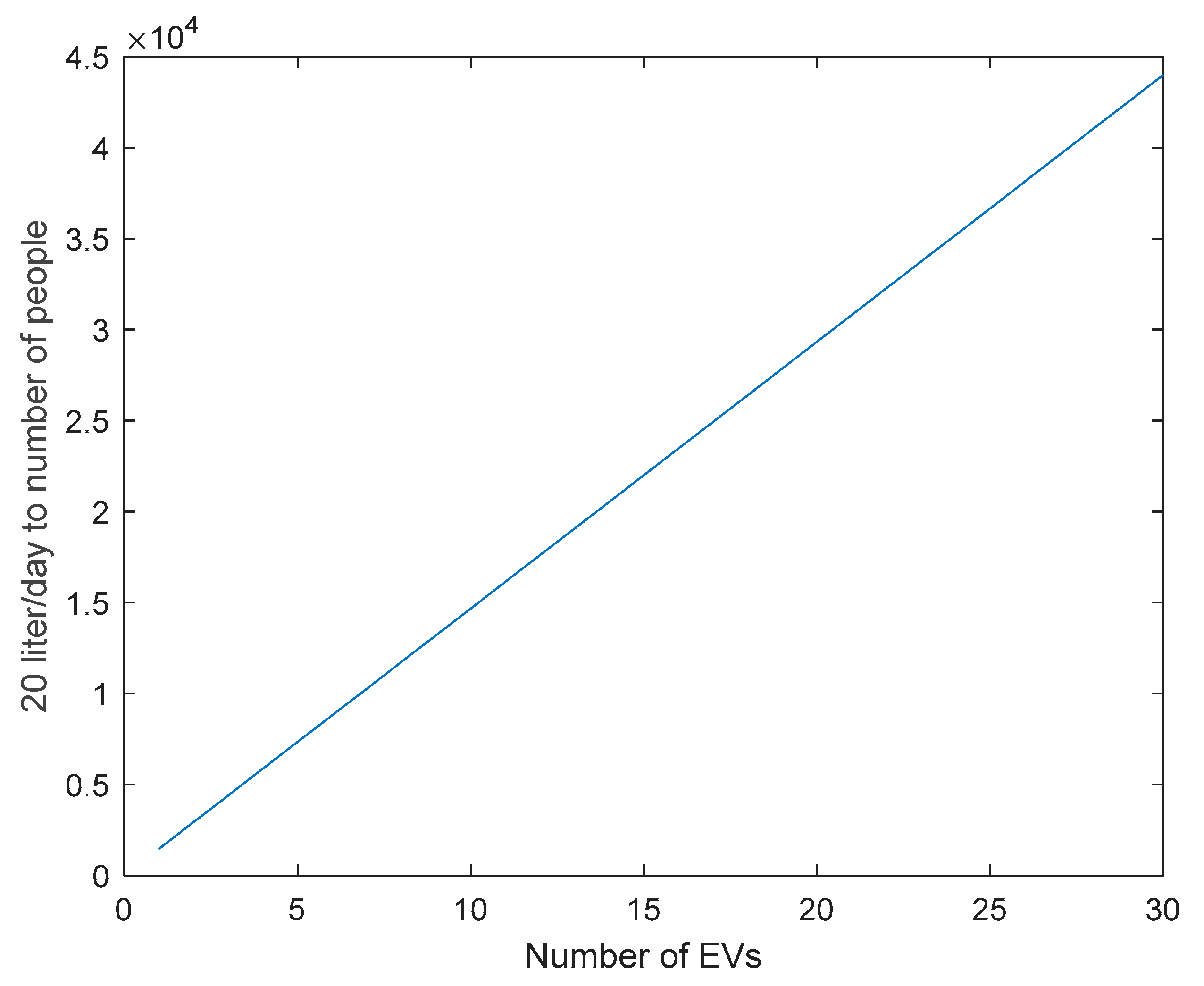Vehicle-to-Water (V2W) Concept for Disaster Relief to Ensure Safe Access to Freshwater and Electricity—A Proposed System Where Electric Vehicles Power the Desalination Process
Abstract
:1. Introduction
1.1. Desalination
1.2. Electric Vehicles and Vehicle-to-Grid
1.3. Aim of This Study
2. Proposed Mobile Water System
2.1. System Overview
2.2. RO Desalination System
3. Case Study of V2W Concept
4. Results of Case Study
4.1. One Vehicle
4.1.1. One Vehicle with RO System
4.1.2. One Vehicle and Several Rainman RO Units
4.2. Several Vehicles
4.3. One Small City
5. Discussion
6. Conclusions
Author Contributions
Funding
Conflicts of Interest
References
- United Nations. Transforming Our World: The 2030 Agenda for Sustainable Development; United Nations: New York, NY, USA, 2015. [Google Scholar]
- Chang, N.B.; Hossain, U.; Valencia, A.; Qiu, J.; Kapucu, N. The Role of Food-Energy-Water Nexus Analyses in Urban Growth Models for Urban Sustainability: A Review of Synergistic Framework. Sustain. Cities Soc. 2020, 63, 102486. [Google Scholar] [CrossRef]
- Lubega, W.N.; Farid, A.M. A Reference System Architecture for the Energy-Water Nexus. IEEE Syst. J. 2016, 10, 106–116. [Google Scholar] [CrossRef]
- Mahlknecht, J.; González-Bravo, R.; Loge, F.J. Water-Energy-Food Security: A Nexus Perspective of the Current Situation in Latin America and the Caribbean. Energy 2020, 194, 116824. [Google Scholar] [CrossRef]
- Wang, X.C.; Jiang, P.; Yang, L.; Van Fan, Y.; Klemeš, J.J.; Wang, Y. Extended Water-Energy Nexus Contribution to Environmentally-Related Sustainable Development Goals. Renew. Sustain. Energy Rev. 2021, 150, 111485. [Google Scholar] [CrossRef]
- Rodríguez-Merchan, V.; Ulloa-Tesser, C.; Baeza, C.; Casas-Ledón, Y. Evaluation of the Water–Energy Nexus in the Treatment of Urban Drinking Water in Chile through Exergy and Environmental Indicators. J. Clean. Prod. 2021, 317, 128494. [Google Scholar] [CrossRef]
- Bortoleto, A.P.; Franco Barbosa, P.S.; Maniero, M.G.; Guimarães, J.R.; Vieira Junior, L.C.M. A Water-Energy Nexus Analysis to a Sustainable Transition Path for Sao Paulo State, Brazil. J. Clean. Prod. 2021, 319, 128697. [Google Scholar] [CrossRef]
- Liu, S.Y.; Wang, Z.Y.; Han, M.Y.; Wang, G.D.; Hayat, T.; Chen, G.Q. Energy-Water Nexus in Seawater Desalination Project: A Typical Water Production System in China. J. Clean. Prod. 2021, 279, 123412. [Google Scholar] [CrossRef]
- Chenoweth, J.; Al-Masri, R.A. The Impact of Adopting a Water-Energy Nexus Approach in Jordan on Transboundary Management. Environ. Sci. Policy 2021, 118, 49–55. [Google Scholar] [CrossRef]
- Cabrera, P.; Carta, J.A.; Lund, H.; Thellufsen, J.Z. Large-Scale Optimal Integration of Wind and Solar Photovoltaic Power in Water-Energy Systems on Islands. Energy Convers. Manag. 2021, 235, 113982. [Google Scholar] [CrossRef]
- Leijon, J.; Anttila, S.; Frost, A.E.; Kontos, S.; Lindahl, O.; Engström, J.; Leijon, M.; Boström, C. Freshwater and Lithium from Desalination Powered by Marine Energy Sources. Int. J. Offshore Polar Eng. 2020, 30, 283–285. [Google Scholar] [CrossRef]
- Miller, S.; Shemer, H.; Semiat, R. Energy and Environmental Issues in Desalination. Desalination 2015, 366, 2–8. [Google Scholar] [CrossRef]
- Caldera, U.; Breyer, C. Strengthening the Global Water Supply through a Decarbonised Global Desalination Sector and Improved Irrigation Systems. Energy 2020, 200, 117507. [Google Scholar] [CrossRef]
- Peñate, B.; Castellano, F.; Bello, A.; García-Rodríguez, L. Assessment of a Stand-Alone Gradual Capacity Reverse Osmosis Desalination Plant to Adapt to Wind Power Availability: A Case Study. Energy 2011, 36, 4372–4384. [Google Scholar] [CrossRef]
- Gude, V.G.; Nirmalakhandan, N.; Deng, S. Desalination Using Solar Energy: Towards Sustainability. Energy 2011, 36, 78–85. [Google Scholar] [CrossRef]
- Borge-Diez, D.; García-Moya, F.J.; Cabrera-Santana, P.; Rosales-Asensio, E. Feasibility Analysis of Wind and Solar Powered Desalination Plants: An Application to Islands. Sci. Total Environ. 2021, 764, 142878. [Google Scholar] [CrossRef]
- Davies, P.A. Wave-Powered Desalination: Resource Assessment and Review of Technology. Desalination 2005, 186, 97–109. [Google Scholar] [CrossRef]
- Leijon, J.; Boström, C. Freshwater Production from the Motion of Ocean Waves—A Review. Desalination 2018, 435, 161–171. [Google Scholar] [CrossRef]
- Leijon, J.; Forslund, J.; Thomas, K.; Boström, C. Marine Current Energy Converters to Power a Reverse Osmosis Desalination Plant. Energies 2018, 11, 2880. [Google Scholar] [CrossRef] [Green Version]
- Pistocchi, A.; Bleninger, T.; Breyer, C.; Caldera, U.; Dorati, C.; Ganora, D.; Millán, M.M.; Paton, C.; Poullis, D.; Herrero, F.S.; et al. Can Seawater Desalination Be a Win-Win Fix to Our Water Cycle? Water Res. 2020, 182, 115906. [Google Scholar] [CrossRef]
- Ram, M.; Osorio-Aravena, J.C.; Aghahosseini, A.; Bogdanov, D.; Breyer, C. Job Creation during a Climate Compliant Global Energy Transition across the Power, Heat, Transport, and Desalination Sectors by 2050. Energy 2021, 238, 121690. [Google Scholar] [CrossRef]
- Solanke, T.U.; Ramachandaramurthy, V.K.; Yong, J.Y.; Pasupuleti, J.; Kasinathan, P.; Rajagopalan, A. A Review of Strategic Charging–Discharging Control of Grid-Connected Electric Vehicles. J. Energy Storage 2020, 28, 101193. [Google Scholar] [CrossRef]
- Tan, K.M.; Ramachandaramurthy, V.K.; Yong, J.Y. Integration of Electric Vehicles in Smart Grid: A Review on Vehicle to Grid Technologies and Optimization Techniques. Renew. Sustain. Energy Rev. 2016, 53, 720–732. [Google Scholar] [CrossRef]
- Bibak, B.; Tekiner-Moğulkoç, H. A Comprehensive Analysis of Vehicle to Grid (V2G) Systems and Scholarly Literature on the Application of Such Systems. Renew. Energy Focus 2021, 36, 1–20. [Google Scholar] [CrossRef]
- Krueger, H.; Cruden, A. Integration of Electric Vehicle User Charging Preferences into Vehicle-to-Grid Aggregator Controls. Energy Rep. 2020, 6, 86–95. [Google Scholar] [CrossRef]
- Mullan, J.; Harries, D.; Bräunl, T.; Whitely, S. The Technical, Economic and Commercial Viability of the Vehicle-to-Grid Concept. Energy Policy 2012, 48, 394–406. [Google Scholar] [CrossRef]
- Li, S.; Gu, C.; Zeng, X.; Zhao, P.; Pei, X.; Cheng, S. Vehicle-to-Grid Management for Multi-Time Scale Grid Power Balancing. Energy 2021, 234, 121201. [Google Scholar] [CrossRef]
- Triviño-Cabrera, A.; Aguado, J.A.; de la Torre, S. Joint Routing and Scheduling for Electric Vehicles in Smart Grids with V2G. Energy 2019, 175, 113–122. [Google Scholar] [CrossRef]
- Wu, W.; Lin, B. Benefits of Electric Vehicles Integrating into Power Grid. Energy 2021, 224, 120108. [Google Scholar] [CrossRef]
- Jafari, M.; Kavousi-Fard, A.; Niknam, T.; Avatefipour, O. Stochastic Synergies of Urban Transportation System and Smart Grid in Smart Cities Considering V2G and V2S Concepts. Energy 2021, 215, 119054. [Google Scholar] [CrossRef]
- Corchero, C.; Sanmarti, M. Vehicle-to-Everything (V2X): Benefits and Barriers. In Proceedings of the 2018 15th International Conference on the European Energy Market (EEM), Lodz, Poland, 27–29 June 2018; IEEE: Lodz, Poland, 2018; pp. 12–15. [Google Scholar]
- Amin, A.; Tareen, W.U.K.; Usman, M.; Ali, H.; Bari, I.; Horan, B.; Mekhilef, S.; Asif, M.; Ahmed, S.; Mahmood, A. A Review of Optimal Charging Strategy for Electric Vehicles under Dynamic Pricing Schemes in the Distribution Charging Network. Sustainability 2020, 12, 10160. [Google Scholar] [CrossRef]
- Ghotge, R.; van Wijk, A.; Lukszo, Z. Off-Grid Solar Charging of Electric Vehicles at Long-Term Parking Locations. Energy 2021, 227, 120356. [Google Scholar] [CrossRef]
- Tu, T.; Rajarathnam, G.P.; Vassallo, A.M. Synergic Integration of Desalination and Electric Vehicle Loads with Hybrid Micro-grid Sizing and Control: An Island Case Study. Energy Storage 2020, 2, e104. [Google Scholar] [CrossRef] [Green Version]
- Sayarshad, H.R.; Mahmoodian, V. An Intelligent Method for Dynamic Distribution of Electric Taxi Batteries between Charging and Swapping Stations. Sustain. Cities Soc. 2020, 65, 102605. [Google Scholar] [CrossRef]
- Rainman Desalination. Portable Electric Desalinator Operation Manual v1.9AC; Rainman Desalination: Sydney, Australia, 2019. [Google Scholar]
- Schallenberg-Rodríguez, J.; Veza, J.M.; Blanco-Marigorta, A. Energy Efficiency and Desalination in the Canary Islands. Renew. Sustain. Energy Rev. 2014, 40, 741–748. [Google Scholar] [CrossRef]
- Shahzad, M.W.; Burhan, M.; Ang, L.; Ng, K.C. Energy-Water-Environment Nexus Underpinning Future Desalination Sustainability. Desalination 2017, 413, 52–64. [Google Scholar] [CrossRef]
- Nilsson, K.; Soares, J.; Ivanell, S. Energy Transition Gotland: Renewable Resources and System Effects; Uppsala University: Uppsala, Sweden, 2018; Volume 1. [Google Scholar]
- World Health Organization. WHO Guidelines for Drinking-Water Quality; World Health Organization: Geneva, Switzerland, 2011. [Google Scholar]





Publisher’s Note: MDPI stays neutral with regard to jurisdictional claims in published maps and institutional affiliations. |
© 2021 by the authors. Licensee MDPI, Basel, Switzerland. This article is an open access article distributed under the terms and conditions of the Creative Commons Attribution (CC BY) license (https://creativecommons.org/licenses/by/4.0/).
Share and Cite
Leijon, J.; Lindahl, O. Vehicle-to-Water (V2W) Concept for Disaster Relief to Ensure Safe Access to Freshwater and Electricity—A Proposed System Where Electric Vehicles Power the Desalination Process. World Electr. Veh. J. 2021, 12, 179. https://doi.org/10.3390/wevj12040179
Leijon J, Lindahl O. Vehicle-to-Water (V2W) Concept for Disaster Relief to Ensure Safe Access to Freshwater and Electricity—A Proposed System Where Electric Vehicles Power the Desalination Process. World Electric Vehicle Journal. 2021; 12(4):179. https://doi.org/10.3390/wevj12040179
Chicago/Turabian StyleLeijon, Jennifer, and Olof Lindahl. 2021. "Vehicle-to-Water (V2W) Concept for Disaster Relief to Ensure Safe Access to Freshwater and Electricity—A Proposed System Where Electric Vehicles Power the Desalination Process" World Electric Vehicle Journal 12, no. 4: 179. https://doi.org/10.3390/wevj12040179
APA StyleLeijon, J., & Lindahl, O. (2021). Vehicle-to-Water (V2W) Concept for Disaster Relief to Ensure Safe Access to Freshwater and Electricity—A Proposed System Where Electric Vehicles Power the Desalination Process. World Electric Vehicle Journal, 12(4), 179. https://doi.org/10.3390/wevj12040179






